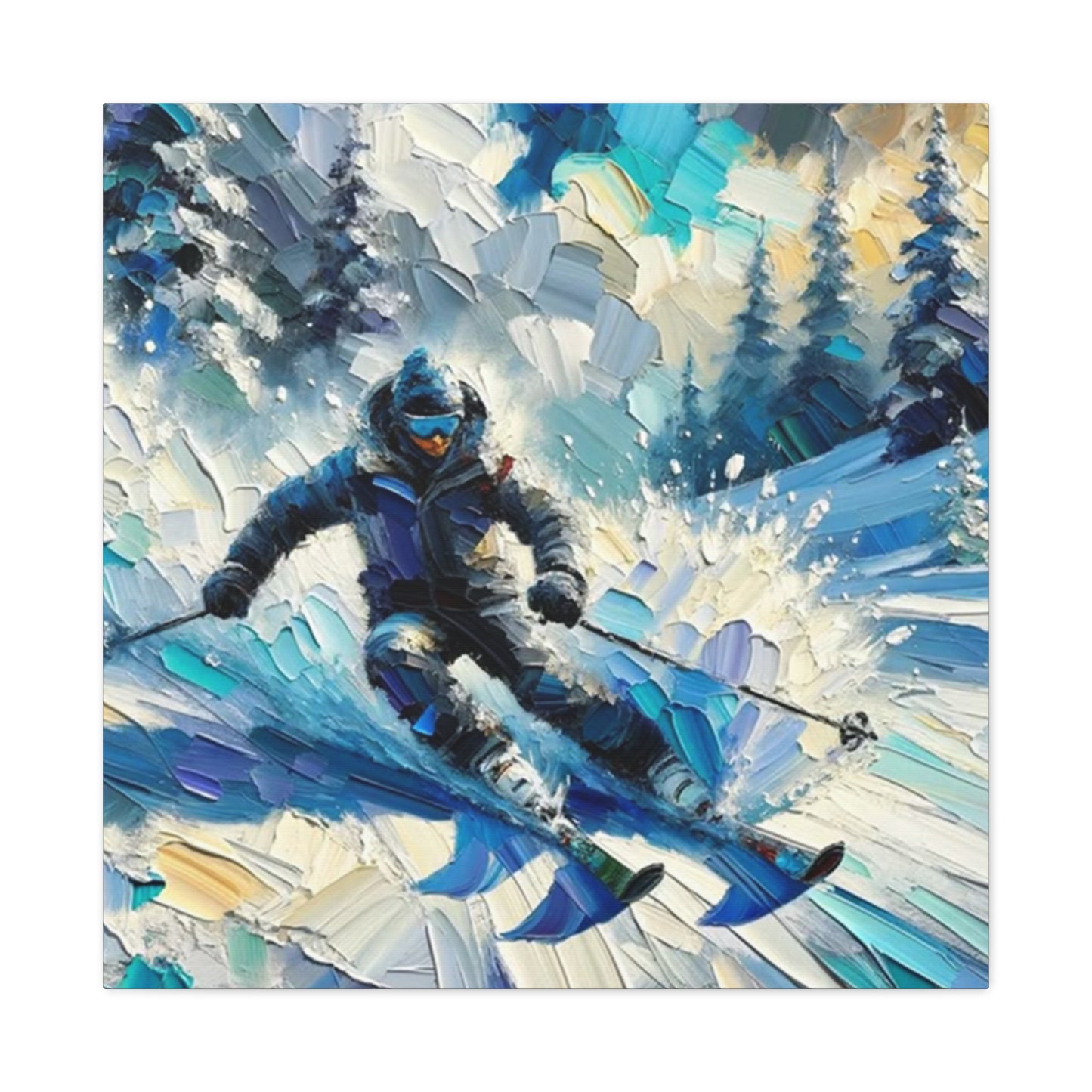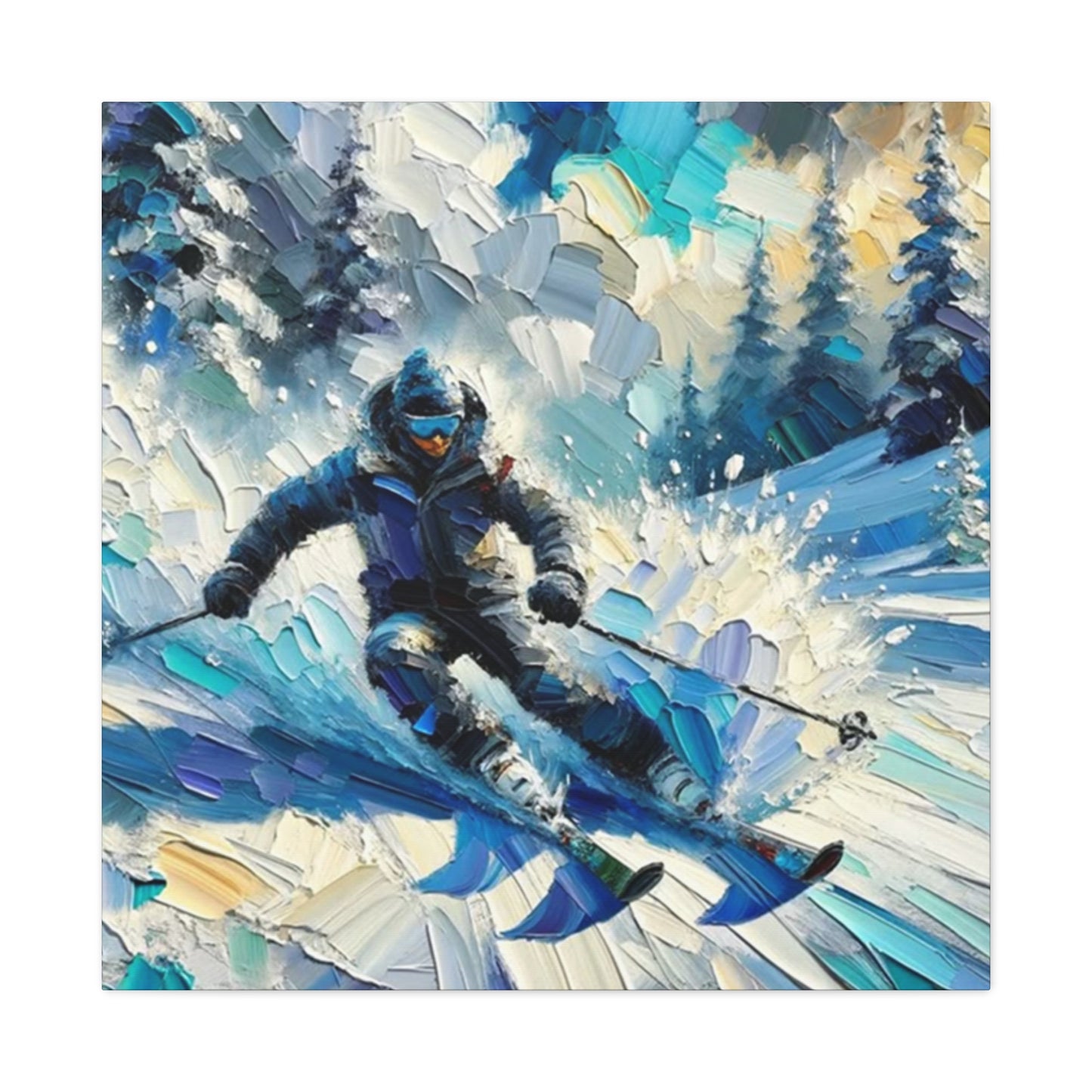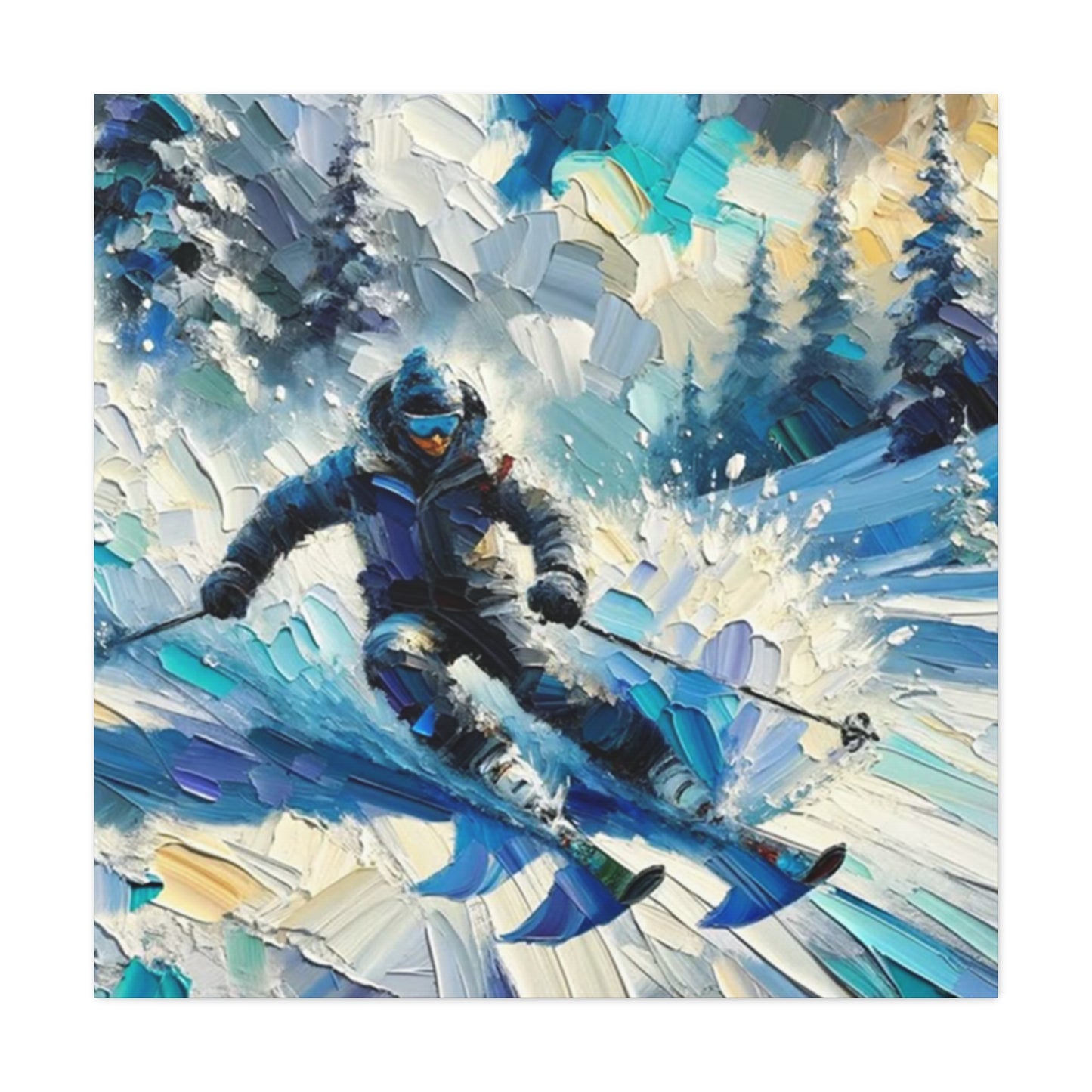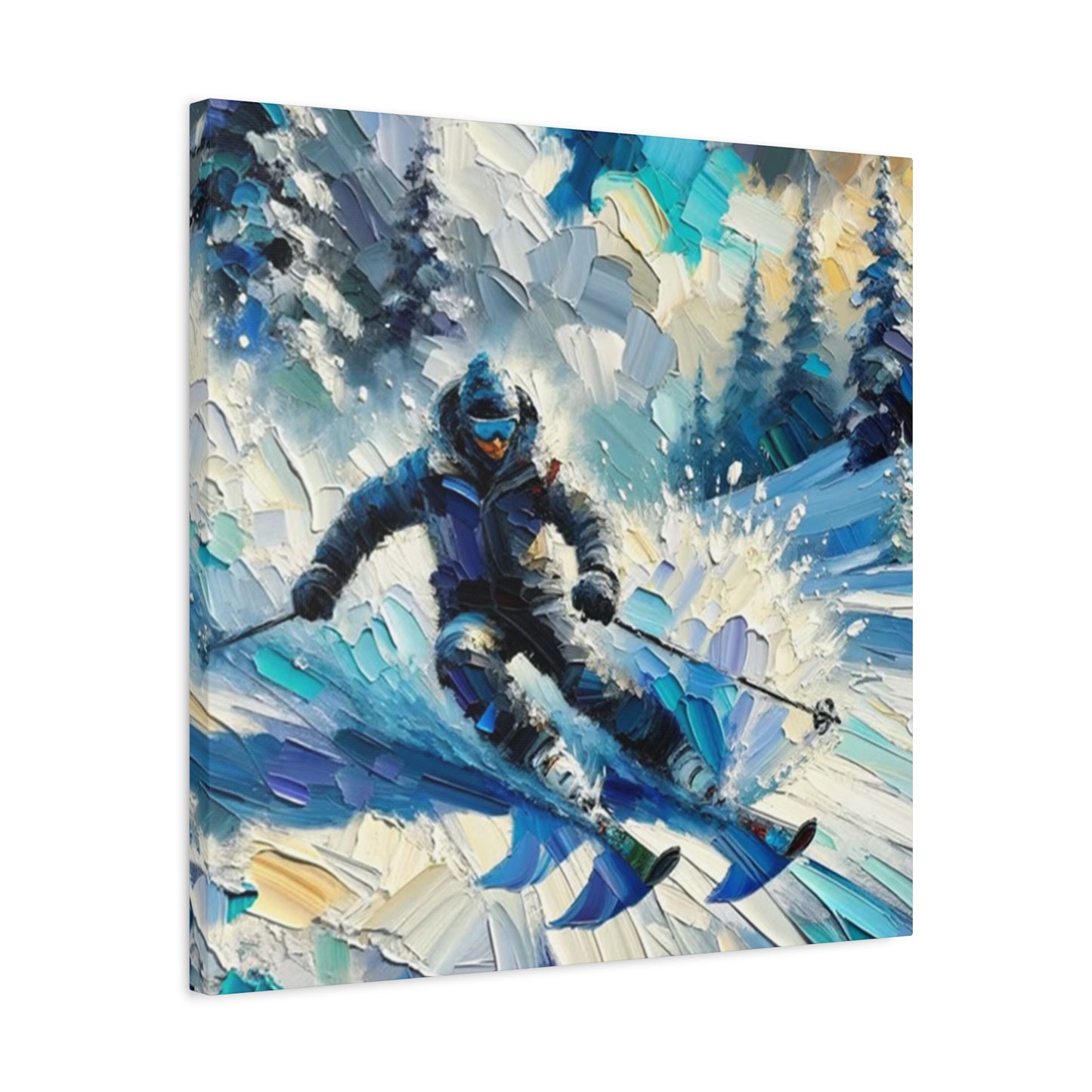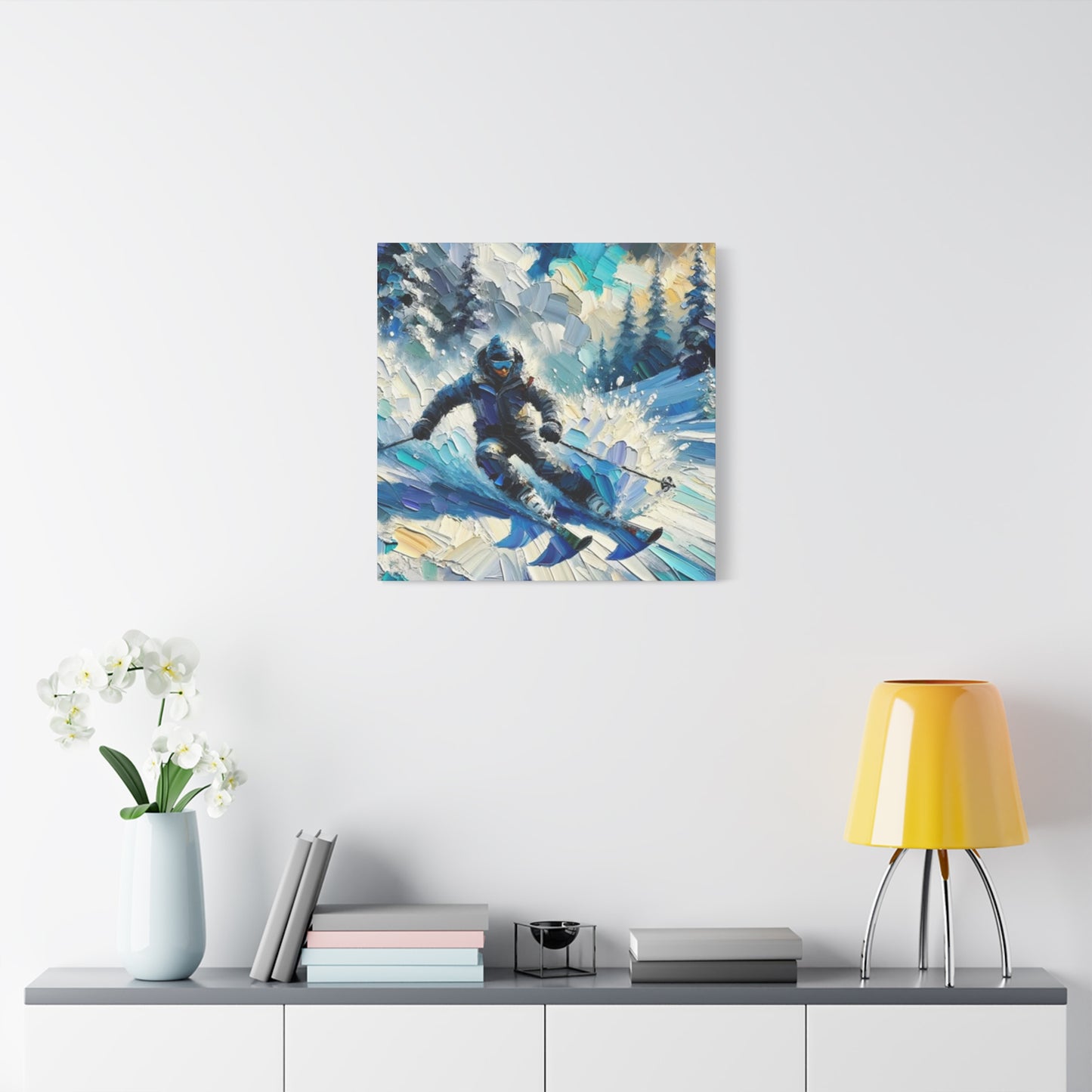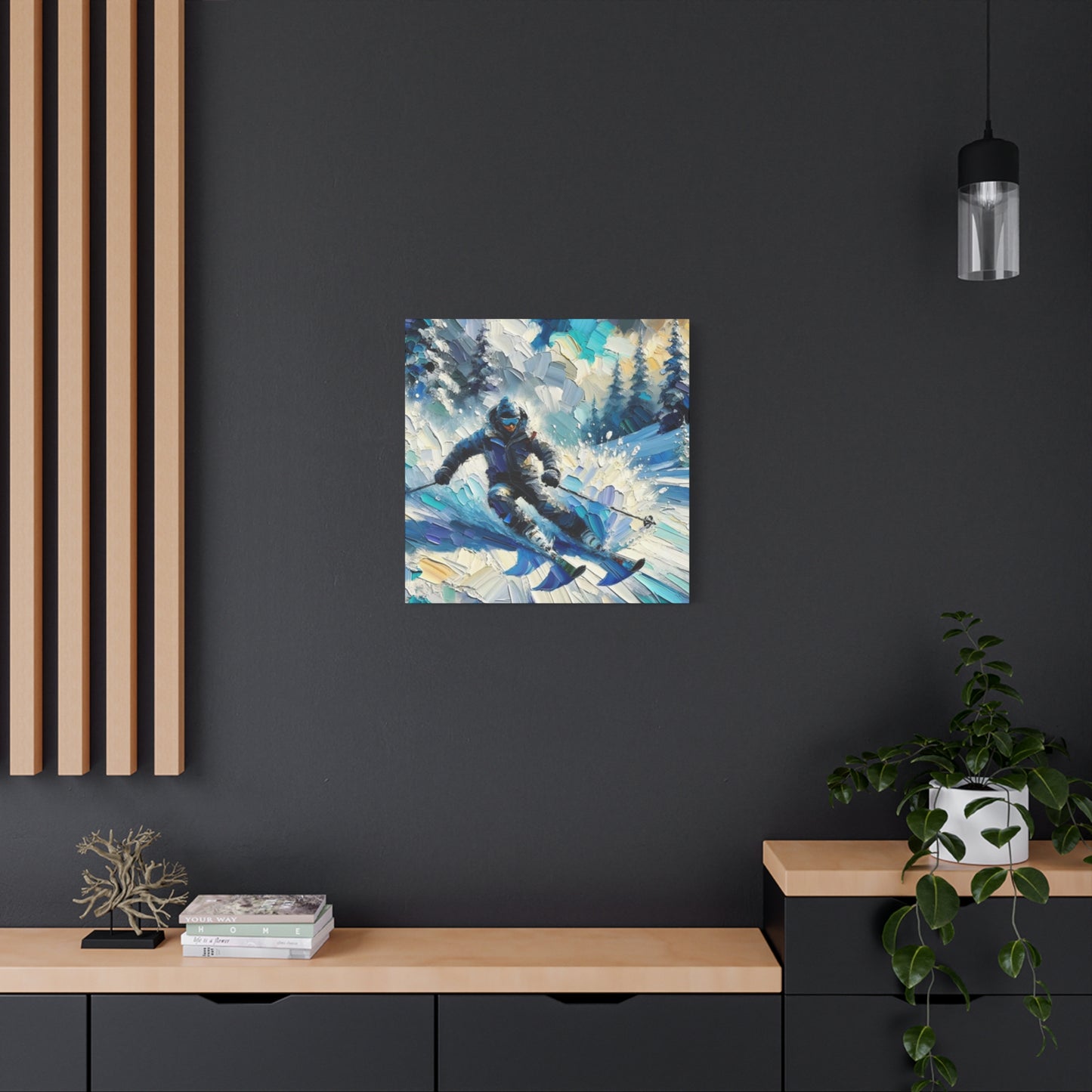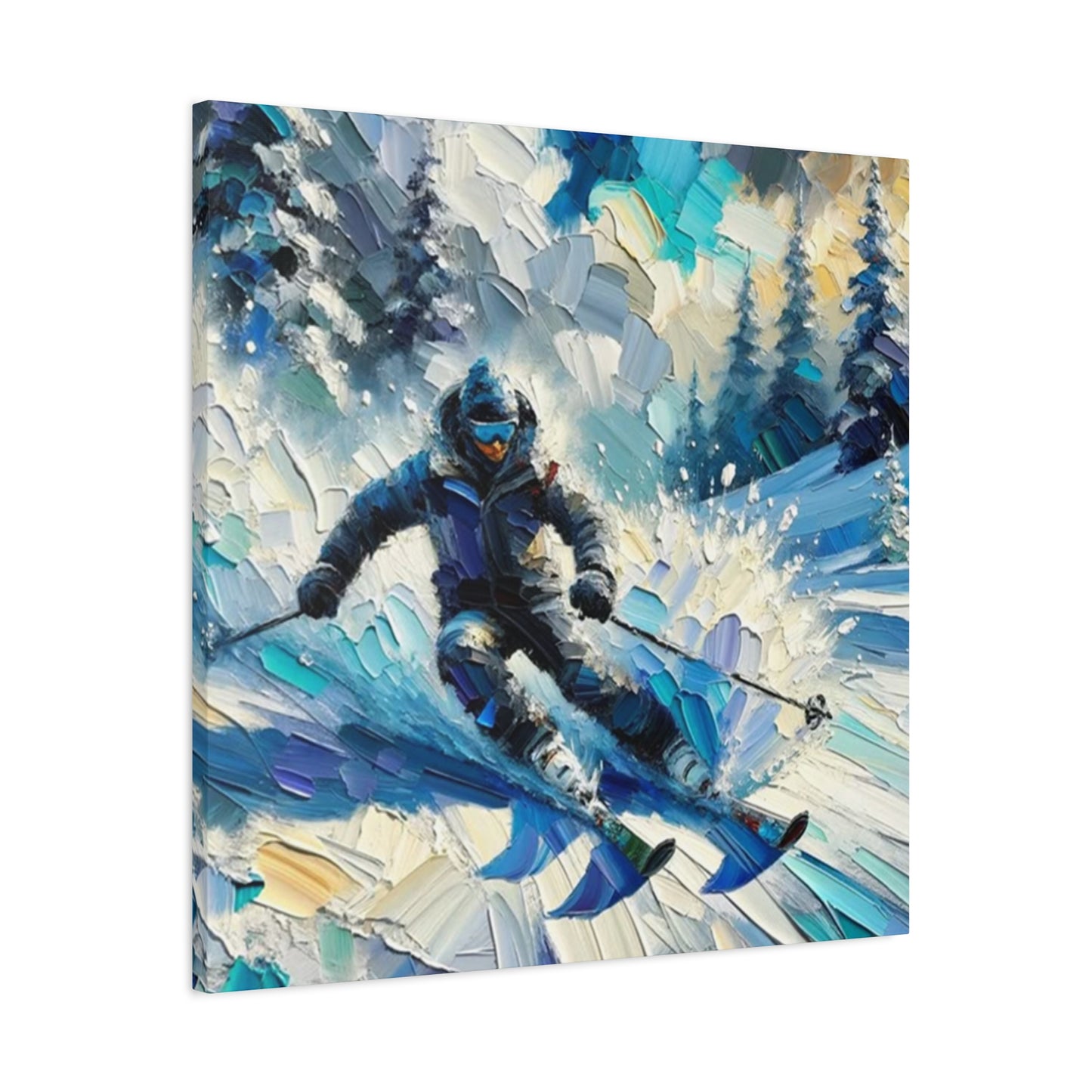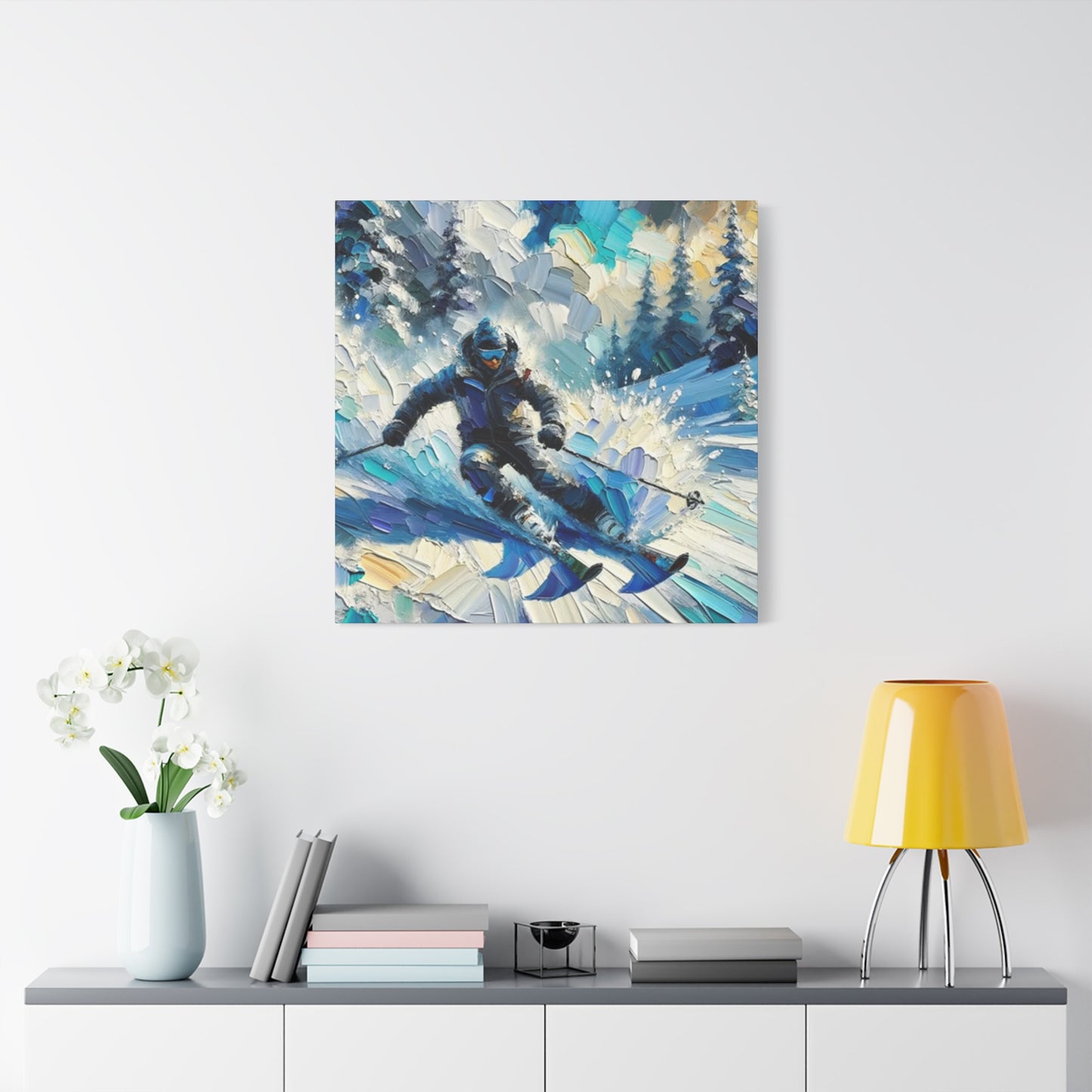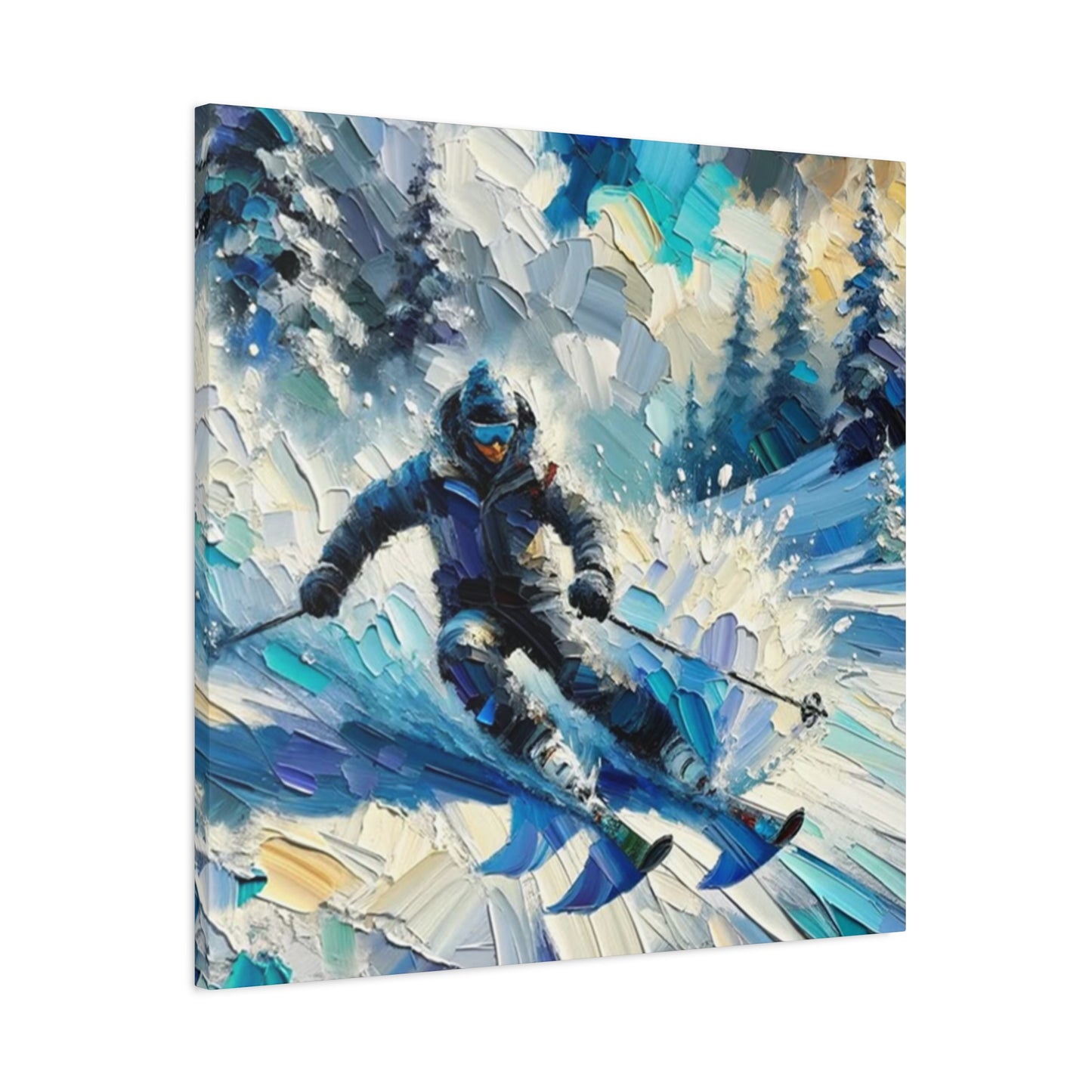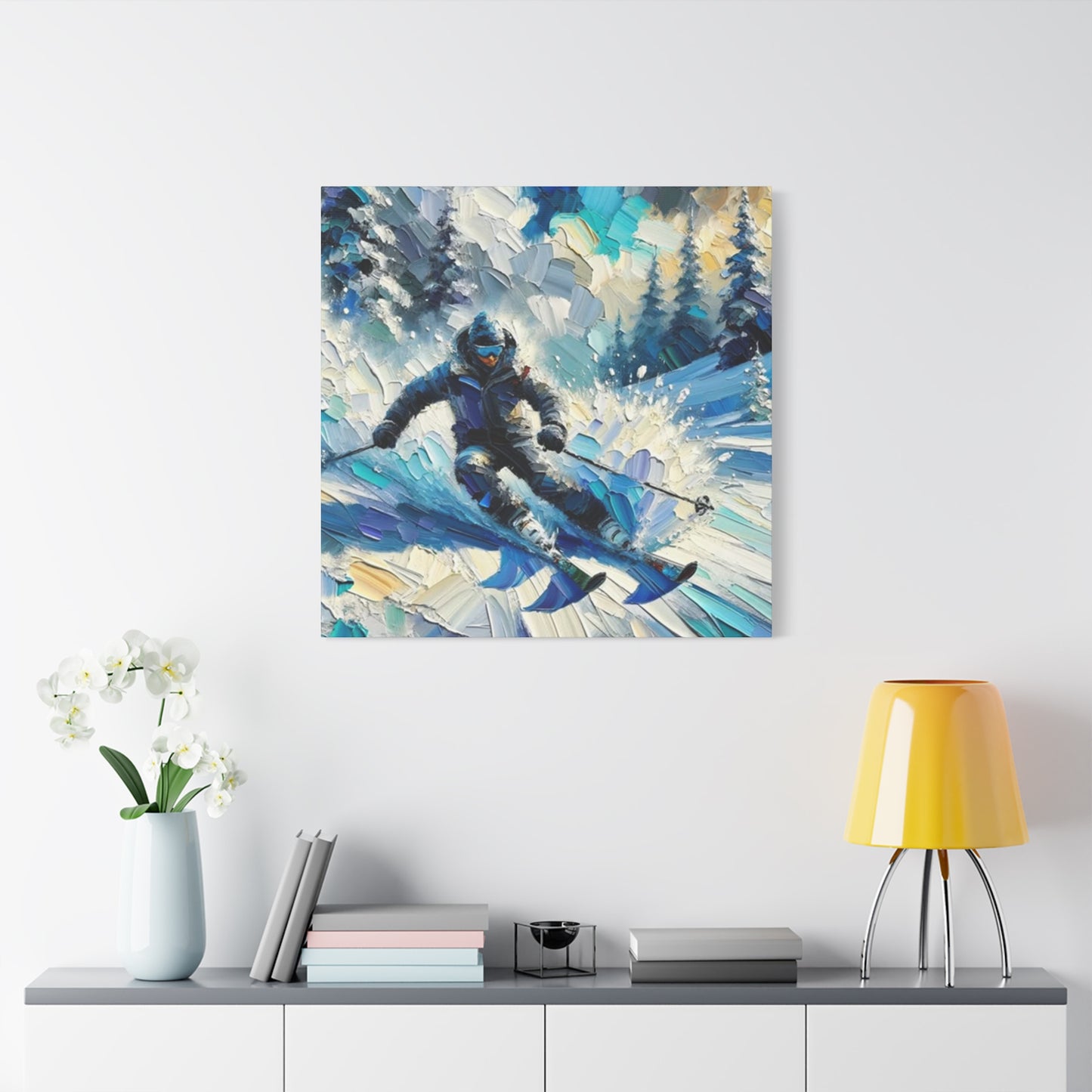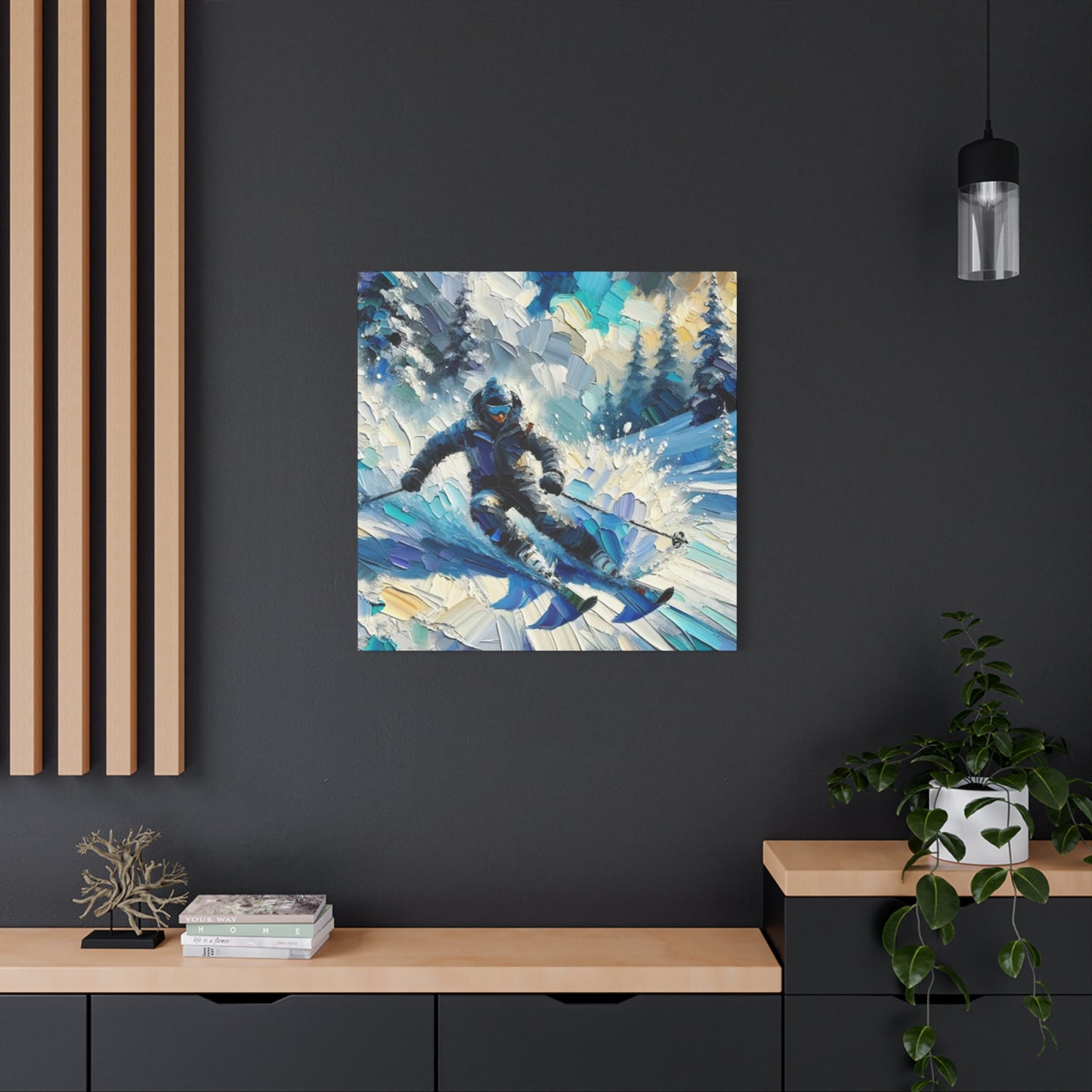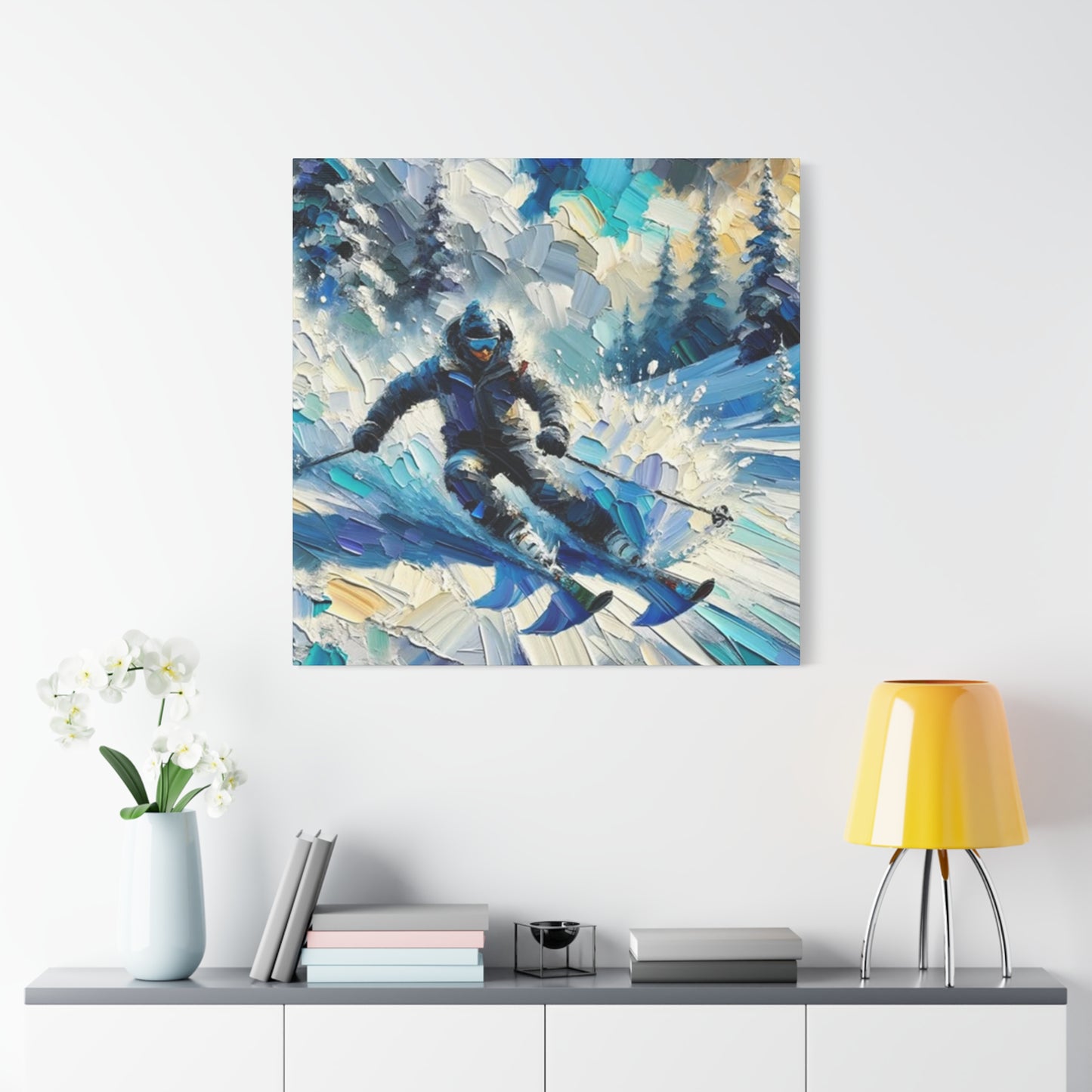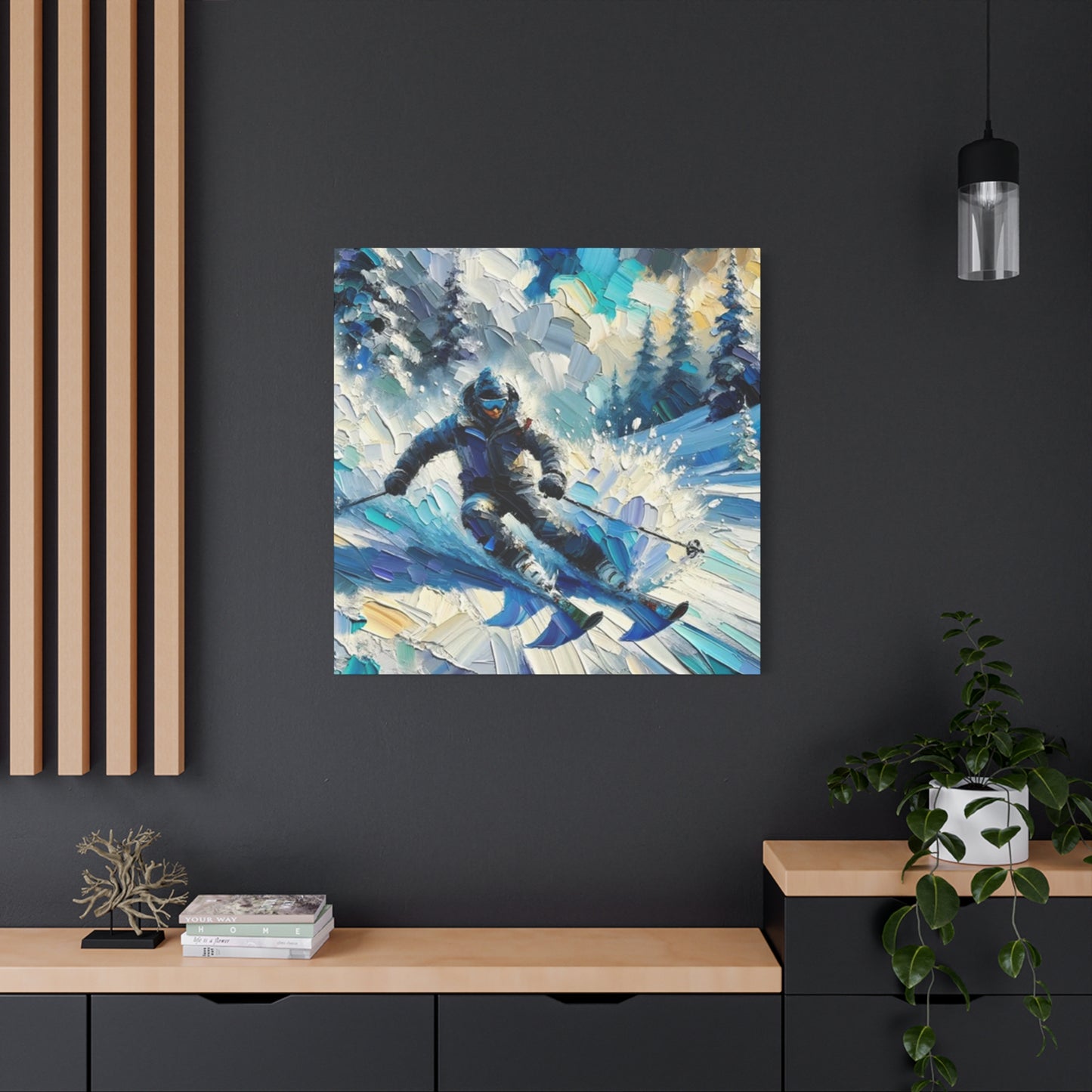Capturing Winter's Majesty: The Artistry of Skiing in Snow Mountains Painting Wall Art
The visual representation of winter sports against breathtaking mountain landscapes has captivated art enthusiasts and interior designers for generations. Skiing in snow mountains painting wall art represents more than mere decoration; it embodies the spirit of adventure, the raw beauty of nature, and the exhilaration of gliding down pristine slopes. This artistic genre has evolved significantly over the decades, transitioning from traditional oil paintings to contemporary mixed media interpretations that grace modern living spaces worldwide.
The allure of alpine skiing artwork stems from its ability to transport viewers to majestic peaks covered in powdery snow, where the crisp mountain air seems almost tangible through the canvas. These artworks capture fleeting moments of human interaction with nature at its most spectacular, freezing dynamic motion against serene backdrops. Whether depicting solitary skiers carving through untouched snow or groups navigating challenging terrain, these pieces evoke powerful emotions ranging from peaceful contemplation to adrenaline-fueled excitement.
Interior decorators have long recognized the versatility of winter sports themed artwork in creating focal points within residential and commercial spaces. The cool color palettes typically associated with snowy mountain scenes provide excellent contrast in rooms with warm tones, while the sense of movement inherent in skiing imagery adds dynamic energy to otherwise static environments. From cozy mountain chalets to sophisticated urban apartments, skiing in snow mountains painting wall art adapts seamlessly to diverse aesthetic preferences and architectural styles.
Compositional Strategies for Dynamic Skiing Artwork
Effective composition separates memorable skiing in snow mountains painting wall art from forgettable decorative pieces. Artists must consider multiple elements simultaneously: the placement of the skier or skiers within the frame, the arrangement of mountain peaks and terrain features, the direction and quality of light, and the balance between detailed areas and simplified passages. Strong compositions guide viewer attention through the image in a deliberate sequence, creating visual narratives that engage observers beyond initial impression.
The rule of thirds provides a reliable framework for positioning key elements within skiing compositions. By placing the primary skier at intersections of imaginary lines dividing the canvas into thirds both horizontally and vertically, artists create more dynamic, professionally balanced compositions than those with centered subjects. Similarly, positioning the horizon line at either the upper or lower third rather than dead center generates more interesting spatial relationships and emphasizes either the dramatic sky or the textured terrain.
Diagonal lines inject energy and movement into skiing artwork, naturally complementing the downhill trajectory of the sport itself. Artists frequently arrange skiers, ski tracks, tree lines, or mountain ridges along diagonal axes that lead viewer eyes through the composition. These diagonal elements create implicit motion even in static images, enhancing the sense of speed and athletic dynamism essential to capturing skiing's exhilarating nature. Contrasting diagonals moving in different directions can add complexity and visual tension that sustains viewer interest.
Atmospheric perspective remains crucial for conveying the vast scale of mountain environments. By progressively reducing contrast, detail, and color saturation in more distant elements while maintaining crisp definition in foreground areas, artists create convincing illusions of deep space. This technique proves particularly important in skiing artwork, where dramatic vertical relief and multiple receding planes of mountains must be clearly distinguished. The gradual shift from sharp, detailed foreground snow textures to hazy, simplified distant peaks helps viewers comprehend the enormous scale of alpine landscapes.
Capturing Motion and Action in Skiing Paintings
Representing dynamic movement presents one of the greatest challenges in creating compelling skiing in snow mountains painting wall art. Unlike photography's ability to freeze split-second moments, painters must suggest motion through carefully considered artistic choices regarding body position, equipment placement, snow spray effects, and compositional flow. The goal involves creating frozen moments that nonetheless communicate speed, balance, and physical exertion to viewers who have never experienced skiing firsthand.
Body language and pose selection prove critical for conveying athletic movement and skiing technique. Artists study how skiers shift their weight, angle their bodies relative to slopes, and position their arms for balance during various maneuvers. A skier leaning into a turn with poles planted and edges carving through snow communicates controlled aggression quite differently from an upright beginner cautiously traversing a gentle slope. Capturing these subtle postural differences requires careful observation of actual skiers or reference photographs showing authentic positions rather than generic athletic poses.
Snow spray and powder trails provide powerful visual indicators of motion and speed in skiing artwork. When skiers make aggressive turns or descend through deep powder, displaced snow creates dramatic plumes and arcs that trace their paths down the mountain. Artists represent these ephemeral effects through loose brushwork, strategically placed highlights suggesting airborne snow crystals catching light, and carefully considered value transitions showing snow spray against both light skies and dark tree backgrounds. These elements add immediacy and excitement while helping viewers track the skier's trajectory through the composition.
Blurred backgrounds and selective focus techniques adapted from photography can enhance motion perception in painted skiing scenes. By rendering distant mountains and background elements with softer edges and reduced detail while maintaining crisp definition on the primary skier, artists create the visual equivalent of motion blur. This approach directs attention to the action figure while suggesting the rapid movement of both skier and viewer perspective through the mountain environment. However, this technique requires restraint; excessive blurring can appear merely unfinished rather than intentionally kinetic.
Lighting Conditions and Atmospheric Effects in Alpine Art
Lighting dramatically influences the mood, color, and overall impact of skiing in snow mountains painting wall art. Alpine environments present unique lighting challenges and opportunities due to high altitude clarity, snow's reflective properties, and the complex interplay between direct sunlight, diffused sky light, and reflected illumination bouncing between snow surfaces and cloud formations. Artists who master these lighting subtleties create more convincing and emotionally resonant winter mountain scenes.
Bright midday sunshine on pristine snow creates intense contrasts between dazzling highlights and deep blue-violet shadows. This high-contrast lighting situation requires careful observation to avoid paintings that feel harsh or overexposed. Successful artists modulate pure whites with subtle warm or cool tones, preventing flat, chalky snow surfaces while preserving the intense brightness characteristic of sunlit alpine slopes. Shadow areas offer opportunities to introduce rich color variation, with reflected sky light often creating surprisingly blue or purple tones in areas not receiving direct sunlight.
Overcast conditions produce entirely different lighting scenarios that many artists find appealing for their subtle tonal relationships and muted color harmonies. Cloudy skies create soft, even illumination without strong directional shadows, emphasizing form through gentle value gradations rather than dramatic light-dark contrasts. These conditions allow skiers' colorful clothing and equipment to stand out vividly against neutral gray-white backgrounds. Fog or low clouds partially obscuring mountain peaks add mystery and atmosphere while helping establish depth through progressively lighter values in receding planes.
Golden hour and alpenglow provide spectacular lighting opportunities that many artists favor for their warm color palettes and dramatic long shadows. During sunrise and sunset, horizontal light rays create extended shadows across snowy terrain, adding texture and dimensional quality to otherwise flat snow fields. Mountain peaks catching first or last light while valleys remain in shadow create powerful compositional contrasts and focal points. The warm orange-pink illumination during these times introduces welcome color variation into predominantly cool winter scenes.
Perspective and Scale in Mountain Landscape Artwork
Convincingly representing the immense scale of mountain environments poses significant challenges in skiing in snow mountains painting wall art. Artists must employ multiple perspective techniques simultaneously to help viewers comprehend the vertical relief, horizontal expanse, and three-dimensional complexity of alpine terrain. Successful scale representation makes viewers feel simultaneously awed by nature's grandeur and connected to the human skier navigating this magnificent landscape.
Linear perspective principles guide the construction of architectural elements like ski lodges, chairlifts, and fence lines within mountain scenes. Parallel lines receding into distance converge toward vanishing points on the horizon, creating systematic diminution that reinforces spatial depth. However, natural mountain forms rarely conform to geometric perspective rules, requiring artists to rely more heavily on atmospheric perspective, overlapping forms, and relative size relationships to establish convincing spatial recession across irregular terrain.
The strategic placement and scale of human figures proves essential for establishing size relationships within mountain landscapes. A tiny skier positioned against an enormous peak immediately communicates the mountain's vast scale, creating powerful visual impact through extreme contrast. Conversely, larger, more detailed skiers in foreground areas draw viewers into the scene, encouraging identification with the athlete's experience. Many effective compositions include multiple figures at varying distances, creating a sense of scale progression from immediate foreground to distant background.
Overlapping mountain ridges and terrain features provide clear depth cues that help viewers mentally organize complex alpine topography. Each successive ridge or peak partially obscuring more distant elements establishes clear spatial layers. Artists enhance these overlapping relationships through value and color temperature shifts, with each more distant layer becoming progressively lighter, cooler, and less detailed. This layering technique proves particularly effective for representing the typical alpine landscape structure of multiple parallel mountain ranges receding toward the horizon.
Subject Matter Variations in Skiing Wall Art
Skiing in snow mountains painting wall art encompasses diverse subject matter beyond simple depictions of athletic figures descending slopes. Artists explore numerous thematic variations within this genre, each offering different aesthetic qualities and emotional resonance. Understanding these variations helps collectors and decorators select artwork that best matches their personal preferences and intended display environments.
Alpine village scenes combining quaint mountain architecture with surrounding ski slopes provide warmth and human interest within winter mountain settings. These compositions typically feature traditional chalets with steep roofs shedding snow, glowing windows suggesting cozy interiors, and perhaps smoke rising from stone chimneys. Skiers might appear as secondary elements descending nearby slopes or gathering in village squares. These scenes appeal to viewers who appreciate European alpine charm and nostalgic winter ambiance rather than purely athletic or wilderness focused imagery.
Backcountry and wilderness skiing artwork emphasizes pristine, untouched mountain environments far from developed ski resorts. These compositions celebrate the adventurous spirit of skiers who climb remote peaks to access untracked powder, facing natural challenges without the infrastructure of groomed runs and mechanical lifts. Artists creating this work often minimize or entirely omit human presence, focusing instead on vast, unspoiled snowscapes with perhaps a single tiny figure for scale. This approach appeals to viewers who value wilderness preservation and adventurous independence.
Competition skiing scenes capture the intensity, precision, and speed of downhill racing, slalom events, or freestyle aerial performances. These dynamic compositions emphasize athletic prowess, featuring skiers in aggressive racing tucks or mid-air performing complex tricks. Bright racing suits, numbered bibs, and course markers like gates or flags provide colorful accents and narrative context. This subject matter particularly appeals to skiing enthusiasts, former competitors, or those who appreciate sports achievement and human athletic potential.
Social skiing scenarios depict groups of friends or families enjoying recreational skiing together, emphasizing the communal and joyful aspects of winter sports culture. These scenes might show skiers pausing to admire views, children learning on gentle slopes, or groups gathered around mountain refuges. The focus shifts from individual athletic achievement to shared experiences and social connection. This warmer, more accessible subject matter works well in family homes, vacation properties, or social spaces like ski lodge lobbies and restaurants.
Material Considerations for Wall Art Display
The physical materials and production methods used for skiing in snow mountains painting wall art significantly impact both aesthetic qualities and practical considerations like durability, maintenance, and installation. Understanding these material options helps buyers make informed decisions matching their specific requirements, whether seeking investment-quality original artwork or affordable decorative prints for seasonal rotation.
Original paintings on stretched canvas represent the traditional premium option, offering unique artwork with visible brushwork texture that cannot be precisely replicated. Canvas paintings typically arrive ready to hang with finished edges, either wrapped around stretcher bars for a contemporary frameless presentation or designed for traditional framing. The textile surface accepts oil, acrylic, and mixed media applications, with each medium offering distinct surface qualities. Original canvas paintings require more careful placement away from direct sunlight, humidity extremes, and physical contact that might damage delicate painted surfaces.
Gallery-wrapped canvas prints provide the appearance of original paintings at more accessible price points through high-quality digital reproduction processes. Modern giclée printing technology produces archival-quality prints with excellent color accuracy and detail retention on canvas material, sometimes enhanced with textured varnishes simulating brushwork. These prints stretch around wooden frames with image extending over edges, eliminating framing costs while creating contemporary presentation suitable for modern interiors. Canvas prints offer durability advantages over paper prints while maintaining relatively light weight for easy hanging.
Framed paper prints suit traditional aesthetic preferences and provide protection for artwork behind glass or acrylic glazing. Fine art papers range from smooth hot-press surfaces showing precise detail to textured cold-press and watercolor papers adding subtle surface interest. Archival quality printing ensures color stability and longevity when proper paper and ink combinations receive appropriate display conditions. Framing adds presentation polish and protection but increases overall weight, cost, and installation complexity. Glass glazing introduces reflection concerns requiring careful lighting consideration.
Metal prints represent innovative contemporary options featuring photographic or digital artwork infused onto aluminum panels. This production method creates extraordinarily durable, vibrant artwork resistant to moisture, fading, and physical damage. The smooth, modern appearance with brilliant colors and deep blacks particularly suits contemporary interiors and high-traffic commercial installations. Metal prints hang easily using concealed mounting systems and require minimal maintenance beyond occasional dusting. However, the distinctive aesthetic doesn't suit all decor styles, particularly traditional or rustic environments.
Framing and Presentation Options for Mountain Art
Framing choices profoundly influence how skiing in snow mountains painting wall art integrates with surrounding decor while affecting preservation, visual presentation, and overall aesthetic impact. The frame functions as transitional element bridging artwork and architectural environment, either harmonizing quietly or making bold statements that enhance the viewing experience. Understanding framing options helps viewers select presentations that honor the artwork while complementing their personal style preferences.
Traditional wooden frames with classic profiles in neutral finishes provide timeless elegance suitable for both traditional and transitional interiors. Natural wood tones, black, white, silver, and gold finishes offer versatile options coordinating with various color schemes and furniture styles. Ornate frames with decorative molding suit formal traditional settings and classical artwork interpretations, while simpler profiles work better with contemporary pieces or casual environments. Wood frames add warmth and natural material quality that many find appealing for nature-focused artwork like mountain landscapes.
Contemporary metal frames in aluminum or steel create sleek, minimal presentations that emphasize artwork rather than ornamental surroundings. Thin metal profiles in black, silver, or occasionally colorful finishes suit modern and industrial interiors while accommodating artwork of various styles. The clean lines and minimal visual weight make metal frames particularly appropriate for graphic skiing posters and contemporary abstract interpretations of mountain sports. Metal frames generally cost less than comparable quality wood options while offering excellent durability and moisture resistance.
Floating frames create distinctive three-dimensional presentations where artwork appears suspended within the frame, separated from the background by a small gap revealing mounting substrate edges or creating shadow lines. This presentation style suits contemporary aesthetics and adds architectural dimension to wall displays. Floating frames work particularly well with gallery-wrapped canvas pieces, acrylic panels, or artwork on rigid substrates where the dimensional effect enhances modern presentation. The technique draws attention to the artwork's physical presence as object rather than simply as image.
Frameless presentations including gallery-wrapped canvases with painted edges or mounted panels with polished edges offer maximum contemporary minimalism and eliminate transitional boundaries between artwork and surrounding walls. This approach creates clean, uninterrupted visual flow particularly suited to modern and Scandinavian interior design philosophies emphasizing simplicity and reduction. However, frameless presentations may lack the finished, protected quality that frames provide, potentially appearing incomplete in traditional settings or formal environments.
Digital Art and Print Technologies for Skiing Imagery
Modern digital art creation and reproduction technologies have dramatically expanded access to high-quality skiing in snow mountains painting wall art while enabling new creative possibilities for artists working in this genre. Understanding these technologies helps viewers appreciate the spectrum between traditional original artworks and contemporary digital creations, each offering distinct characteristics and value propositions.
Giclée printing represents the current standard for high-quality art reproduction, utilizing inkjet technology with archival pigment inks and fine art papers or canvas to create prints virtually indistinguishable from originals at casual viewing distances. The term giclée, French for "spray" or "squirt," distinguishes this fine art printing from standard poster production using less sophisticated methods. Properly executed giclée prints on archival substrates offer color stability, fade resistance, and longevity approaching or exceeding traditional print media like lithography or screen printing.
Digital painting software enables contemporary artists to create original skiing artwork entirely within digital environments using pressure-sensitive tablets and stylus devices simulating traditional brush behavior. These purely digital creations offer advantages including unlimited undo capability, easy color adjustment, and perfect reproduction without quality loss. However, digital artwork lacks the physical texture and unique surface qualities of traditional media. Some artists create hybrid works beginning with traditional media scanned and enhanced digitally, combining both approaches' advantages.
Limited edition prints provide middle ground between unique original artwork and unlimited reproductions, offering collectors accessibility to artists' work at reduced cost while maintaining some exclusivity through controlled print runs. Artists or publishers designate specific edition sizes, with each print numbered and often signed by the artist. Edition numbers appear as fractions like 25/100, indicating print 25 from a total edition of 100. Smaller editions generally command higher prices reflecting greater rarity, though artist reputation matters far more than edition size alone.
On-demand printing services have democratized access to artwork by eliminating inventory requirements and enabling customers to order prints in various sizes and substrates as needed. This model particularly benefits independent artists and niche subject matter including skiing themes that might not justify traditional print run investments. However, quality varies dramatically between services, with careful research required to identify providers using archival materials, proper color management, and quality control ensuring professional results worthy of display and investment.
Cultural Significance of Skiing in Art and Decoration
Skiing in snow mountains painting wall art carries cultural significance extending beyond mere decoration, reflecting complex relationships between humans and alpine environments, the development of winter sports culture, and evolving attitudes toward nature, leisure, and adventure. Understanding these cultural dimensions enriches appreciation for this artistic genre and informs thoughtful display decisions that honor these deeper meanings.
Alpine skiing culture emerged from practical mountain travel traditions in Scandinavia and Alpine Europe, evolving through military applications into recreational sport and eventually the multi-billion dollar winter tourism industry of today. Artwork depicting skiing documents this cultural evolution, with early works showing utilitarian travel progressing through images of elite tourism and ultimately contemporary representations of skiing as accessible middle-class recreation. This historical progression appears in artistic stylistic evolution from romantic 19th-century landscape traditions through mid-century modernist graphics to today's diverse contemporary approaches.
National identity connections run deep in skiing artwork from countries where winter sports form essential cultural elements. Norwegian, Swiss, Austrian, and French artists have particularly strong traditions of mountain and skiing imagery reflecting these nations' geography and cultural values. Similarly, American and Canadian artists working in mountain resort regions contribute regional perspectives on skiing culture. Collecting artwork from specific national traditions or regional schools offers opportunities to explore cultural differences in approaching similar subject matter.
Environmental consciousness increasingly influences contemporary skiing artwork as artists respond to climate change threatening alpine environments and snow sport viability. Some contemporary works explicitly address ecological themes through imagery emphasizing pristine wilderness requiring protection or contrasting natural beauty with development impacts. Even traditional-appearing skiing artwork often carries implicit environmental messages celebrating wild places and outdoor experiences potentially threatened by global warming. This evolving dimension adds urgency and relevance to the genre.
Social class associations historically attached to skiing imagery reflect the sport's evolution from elite leisure activity to mainstream recreation. Early and mid-century skiing artwork often depicted fashionable, affluent participants and luxurious resort settings, reinforcing skiing's sophisticated cachet. Contemporary representations embrace more diverse participants and settings, from challenging backcountry expeditions to family-friendly resort experiences. These shifting social representations within skiing artwork mirror broader democratization of outdoor recreation and changing attitudes about accessibility to natural environments and athletic pursuits.
Regional Artistic Traditions in Mountain Sports Imagery
Different geographic regions have developed distinctive artistic traditions for representing skiing and mountain landscapes, each reflecting local cultural values, aesthetic preferences, and relationships with alpine environments. These regional variations offer collectors diverse stylistic options while providing insight into how different cultures visually interpret similar subjects through distinctive artistic lenses shaped by historical and environmental contexts.
European Alpine art traditions, particularly from Austria, Switzerland, and France, emphasize romantic connections between humans and mountains developed through centuries of Alpine culture. Artists from these regions often portray skiing within broader contexts of village life, agricultural traditions, and architectural heritage. Their compositions frequently include traditional chalets, church steeples, and cultivated valley floors beneath dramatic peaks, suggesting harmonious integration of human culture within mountain landscapes. Color palettes often feature warm earth tones alongside cool mountain whites and blues, reflecting the coexistence of warm valley communities and cold high peaks.
Scandinavian artistic approaches, rooted in Norwegian and Swedish traditions, tend toward cleaner compositions with emphasis on vast open spaces, minimalist elements, and dramatic natural lighting effects. The Nordic aesthetic often features solitary figures against expansive snowscapes, reflecting cultural values around individual relationship with nature and the tradition of solo wilderness travel. These compositions typically employ cooler overall color schemes with subtle color variations and particular attention to quality of natural light during long winter days when low sun angles create extended shadows and atmospheric effects.
North American mountain art reflects the continent's different skiing history, developing primarily in the 20th century around purpose-built resort areas in the Rockies, Sierra Nevada, and other ranges. American and Canadian artists often emphasize the recreational and adventurous aspects of skiing rather than traditional cultural integration, with compositions highlighting dramatic terrain, powder snow conditions, and the thrill of descent. The artistic style frequently shows influence from both European traditions and distinctly American approaches to landscape painting, creating hybrid aesthetics reflecting North America's immigrant cultural heritage and frontier mythology.
Japanese alpine art brings unique aesthetic sensibilities to skiing imagery, influenced by traditional Japanese artistic principles including careful observation of seasonal changes, appreciation for transient natural phenomena, and compositional approaches emphasizing negative space and asymmetrical balance. Contemporary Japanese artists working with skiing subjects often create images feeling simultaneously modern and traditional, incorporating elements of manga and anime visual culture alongside references to classical landscape painting traditions. The results often appear strikingly different from Western skiing artwork while addressing similar themes of human interaction with mountain winter environments.
Creating Custom Commissioned Skiing Artwork
Commissioning custom skiing in snow mountains painting wall art offers ultimate personalization, allowing collectors to obtain unique pieces precisely matching their preferences, spaces, and personal narratives. The commission process requires clear communication, realistic expectations, and understanding of artistic timelines and pricing structures, but results in irreplaceable artwork with special meaning beyond mass-produced alternatives.
Artist selection represents the critical first step, requiring research to identify creators whose existing work demonstrates appropriate style, skill level, and subject matter expertise. Online portfolios, gallery exhibitions, artist websites, and social media presence reveal artistic capabilities and aesthetic sensibilities. Compatibility extends beyond artistic merit to include communication style, professionalism, and ability to interpret client visions while maintaining artistic integrity. Interviewing multiple artists before committing helps ensure good matches between client needs and artist offerings.
Project definition requires articulating preferences regarding size, orientation, color palette, composition elements, level of detail, and any specific features like particular mountains, skiing techniques, or atmospheric conditions. Providing reference materials including photographs of desired locations, existing artwork exemplifying preferred styles, and images of intended display spaces helps artists understand client visions. However, successful commissions balance specific direction with creative freedom, trusting artists' expertise in translating concepts into effective visual compositions. Overly prescriptive requirements may inhibit artistic judgment and compromise aesthetic results.
Contract agreements should formalize commission terms including final artwork dimensions, materials and techniques, delivery timeline, pricing structure with payment schedule, revision policies, and ownership rights. Clear contracts prevent misunderstandings and protect both parties' interests. Typical arrangements include initial deposits upon commission acceptance, progress payments at specified milestones, and final payment upon satisfactory completion before delivery. Revision policies should specify how many adjustment rounds occur within base pricing and charges for additional changes beyond agreed parameters.
Progress reviews at key development stages allow client input while works remain sufficiently incomplete for significant changes without excessive rework. Many artists provide preliminary sketches or digital mockups establishing composition and major elements before investing extensive time in final execution. These reviews offer opportunities for adjustments ensuring finished pieces meet expectations. However, excessive interference during creative processes may frustrate artists and compromise results. Trusting artistic judgment while providing clear feedback when pieces diverge from agreed concepts balances oversight with creative respect.
Pricing considerations reflect multiple factors including artist reputation and experience, artwork size and complexity, materials and techniques employed, and timeline constraints. Original commissioned paintings typically cost significantly more than comparable-sized prints, reflecting unique creation and artistic labor. Realistic budgets recognize that serious artistic training, years of skill development, quality materials, and creative intellectual property justify professional pricing. Attempting to negotiate deeply discounted prices from professional artists generally proves unsuccessful and potentially insulting. Collectors with limited budgets should consider smaller pieces, emerging artists with lower rates, or print alternatives rather than expecting established artists to discount their work substantially.
Skiing Artwork in Contemporary Interior Design Trends
Current interior design movements influence how skiing in snow mountains painting wall art integrates within contemporary spaces, with evolving aesthetic preferences, lifestyle priorities, and cultural values shaping artwork selection, display approaches, and thematic interpretations. Understanding these trends helps collectors make choices that feel current while avoiding overly trendy selections that may appear dated within a few years.
Minimalist and Scandinavian design aesthetics emphasize simplicity, functionality, and edited collections of meaningful objects rather than abundant decoration. Within these frameworks, skiing artwork should feature clean compositions, limited color palettes, and strong visual impact justifying its presence among carefully curated design elements. Single large-scale pieces work better than multiple small works, and frameless presentations or simple frames suit the minimal aesthetic better than ornate framing. Subject matter emphasizing vast empty spaces with minimal human presence aligns with minimalist values around reduction and essential elements.
Maximalist and eclectic approaches celebrate abundant decoration, pattern mixing, and diverse collection displays, providing freedom to incorporate skiing artwork alongside varied decorative elements. These spaces often feature gallery walls combining skiing images with other subjects, vintage ski equipment displayed as sculpture, and layered decorative elements creating rich visual environments. The maximalist approach suits collectors who appreciate vintage ski posters, diverse artistic styles, and creating immersive thematic environments. However, successful maximalism requires curatorial skill preventing spaces from appearing cluttered or chaotic despite abundant decoration.
Biophilic design principles prioritizing natural materials, living elements, and nature connections throughout built environments naturally accommodate skiing artwork depicting mountain landscapes. These spaces often feature reclaimed wood, stone elements, abundant plants, and large windows admitting natural light. Skiing artwork enhances biophilic goals by providing nature imagery and connecting inhabitants with outdoor environments. Material choices for artwork presentation should emphasize natural wood frames, organic textiles, and sustainable production methods aligning with environmental values underlying biophilic design philosophy.
Industrial and modern farmhouse styles combining rustic materials with contemporary clean lines create interesting contexts for skiing artwork. Industrial spaces with exposed brick, concrete floors, and metal elements provide dramatic backdrops for skiing imagery, particularly vintage ski posters with bold graphics or contemporary pieces with strong geometric compositions. Modern farmhouse aesthetics mixing shiplap walls, neutral palettes, and casual elegance suit skiing artwork with traditional subject matter and classic appeal. Both styles benefit from artwork providing personality and individual character within spaces that might otherwise feel generic or overly styled.
Sustainable and eco-conscious design approaches influence artwork acquisition through considerations of environmental impact, production methods, and long-term value. These values favor original artwork and limited edition prints over mass-produced disposables, locally produced pieces reducing transportation impacts, sustainable materials and production processes, and timeless aesthetic choices ensuring long-term appreciation rather than trendy temporary appeal. Skiing artwork's inherent celebration of natural environments aligns with environmental values, particularly pieces suggesting wilderness preservation and climate consciousness.
Pairing Skiing Art with Complementary Decorative Elements
Skiing in snow mountains painting wall art achieves maximum impact when thoughtfully integrated with complementary decorative elements that reinforce thematic coherence, enhance aesthetic appeal, and create cohesive interior narratives. Strategic combinations of furniture, accessories, textiles, and architectural features transform skiing artwork from isolated decoration into integral components of unified design schemes.
Furniture selections with appropriate scale, style, and material qualities support skiing artwork while maintaining distinct identities preventing overly literal thematic coordination. Natural wood furniture with visible grain patterns echoes mountain forests and traditional lodge architecture, creating warmth balancing skiing imagery's cool palettes. Leather upholstery in tan, cognac, or chocolate tones provides rich texture and warm color complementing blue-white artwork. Contemporary furniture with clean lines and minimal ornamentation suits modern skiing imagery, while traditional pieces with classic profiles harmonize with conventional landscape paintings.
Textile selections including throw pillows, blankets, area rugs, and window treatments introduce texture, pattern, and color coordination opportunities. Faux fur throws and sheepskin pillows suggest alpine comfort and tactile luxury while providing visual softness contrasting with framed artwork's hard edges. Plaid patterns reference traditional ski lodge aesthetics and mountain cabin culture, working particularly well with vintage-style skiing artwork. Color coordination through textiles ties artwork into broader room palettes, with pillows or throws incorporating accent colors from skiing scenes distributed throughout spaces.
Decorative accessories extend thematic coherence without overwhelming spaces with skiing references. Vintage ski equipment including wooden skis, poles, and snowshoes displayed as wall sculpture or leaning against walls creates dimensional interest and authentic material culture connection. Mountain-themed objects like pinecones, antlers, stone specimens, and driftwood bring natural elements indoors, reinforcing outdoor adventure associations. Vintage ski resort signage, trail maps, and lift tickets framed as ephemera collections add personal narrative and nostalgic charm.
Lighting fixtures contribute both functional illumination and decorative character, with appropriate selections enhancing skiing artwork and overall design schemes. Rustic chandeliers featuring antler elements or wrought iron construction suit traditional ski lodge aesthetics, while sleek metal pendant lights complement contemporary mountain modern spaces. Warm-toned Edison bulbs create cozy ambiance appropriate for intimate viewing of skiing artwork during evening hours. Table and floor lamps with wood or stone bases echo natural materials referenced in mountain landscape artwork.
Architectural elements including exposed beams, stone fireplaces, and wood paneling create structural frameworks within which skiing artwork achieves enhanced authenticity and contextual appropriateness. These permanent features establish mountain lodge character that skiing artwork reinforces rather than creating alone. Even in spaces lacking dramatic architectural elements, strategic additions like reclaimed wood accent walls, stone veneer surrounds, or beam-style brackets supporting shelving introduce mountain aesthetic foundations supporting skiing artwork displays.
Global Market for Skiing Mountain Artwork
The international market for skiing in snow mountains painting wall art reflects diverse cultural attitudes toward winter sports, varying economic conditions affecting art purchasing patterns, and regional aesthetic preferences shaping demand for specific styles and subjects. Understanding market dynamics helps collectors identify acquisition opportunities, assess artwork value, and appreciate this genre's global significance beyond local contexts.
European markets, particularly in Alpine nations, maintain strong tradition of skiing artwork collection supported by deep cultural connections to mountains and winter sports. Switzerland, Austria, France, and Italy all sustain robust markets for both contemporary and vintage skiing imagery. Auction houses in these regions regularly feature skiing artwork in specialized winter sports sales, while galleries in mountain resort towns offer year-round selections. European collectors often favor artwork depicting regional mountains and resorts, creating specialized markets for pieces representing iconic locations like the Matterhorn, Mont Blanc, or specific Austrian and Swiss valleys.
North American markets concentrate in mountain regions of the western United States and Canada, with particularly active scenes in Colorado, Utah, California, Montana, and British Columbia. Resort communities including Aspen, Vail, Park City, Jackson Hole, Whistler, and Lake Tahoe support galleries specializing in skiing and mountain artwork serving both locals and tourists seeking regional souvenirs. Major urban areas with populations including skiing enthusiasts also maintain market presence, with collectors acquiring artwork maintaining connections to recreational pursuits during off-seasons. The North American market shows strong interest in both contemporary work by regional artists and vintage ski posters from historic resorts.
Asian markets have expanded dramatically in recent decades as skiing grows in popularity across Japan, South Korea, and increasingly China. Japanese collectors demonstrate particular appreciation for both Western skiing artwork and pieces by Japanese artists bringing unique aesthetic sensibilities to mountain sports imagery. South Korean interest has grown alongside expanding domestic ski industry and increasing participation in winter sports. Chinese market development remains early stage but shows promise as wealth increases and skiing infrastructure expands ahead of winter Olympic hosting. These markets favor contemporary styles and may develop distinct Asian skiing art traditions over time.
Online marketplaces have globalized skiing artwork distribution, enabling artists to reach international audiences and collectors to source works from distant regions. Platforms specializing in original art, limited editions, and reproductions connect buyers and sellers across borders, though international shipping costs, customs regulations, and authentication challenges require navigation. Online sales particularly benefit niche categories like skiing artwork where local market depth may prove insufficient for specialized artists, while providing collectors access to broader selections than available through local galleries.
Investment market segments focused on vintage ski posters, works by recognized mountain landscape specialists, and historically significant pieces operate according to established art market principles of rarity, provenance, condition, and cultural significance. Auction records show strong performance for exceptional vintage posters from major European resorts and works by recognized early mountain sports artists. Contemporary market investment potential remains speculative, depending heavily on individual artist career development and broader art market conditions. Most skiing artwork purchases should prioritize aesthetic enjoyment over investment expectations, with potential value appreciation considered bonus rather than primary acquisition motivation.
Creating Cohesive Collections of Skiing Artwork
Building curated collections of skiing in snow mountains painting wall art requires strategic planning balancing personal taste with design principles that ensure individual pieces work together harmoniously while allowing collection growth over time. Thoughtful collection development creates visual narratives richer than individual artworks provide independently, demonstrating sophistication and intentionality in aesthetic choices.
Thematic coherence provides organizational frameworks for collections, with possible themes including specific geographic regions, particular artistic styles or periods, seasonal variations, skiing technique specializations, or favorite artists' work. Regional collections might focus exclusively on Colorado Rockies, European Alps, or Japanese mountains, creating geographic consistency. Style-focused collections could emphasize vintage ski posters, contemporary realist paintings, or minimalist interpretations. These organizing principles guide acquisition decisions while establishing collection identities distinguishing them from random accumulations.
Color palette consistency helps diverse skiing artworks coexist harmoniously within shared spaces despite differences in subject matter or style. Collectors might favor cool-toned pieces emphasizing blues, whites, and grays, creating serene environments with subtle color variation. Alternatively, collections incorporating artwork with warm accent colors like sunset illumination, lodge lights, or colorful skiing attire introduce variety while maintaining overall coherence through coordinated color strategies. Collecting artwork within defined color parameters proves particularly important for open-concept spaces where multiple pieces remain simultaneously visible.
Scale and proportion variety within collections creates visual interest through dynamic contrast between large statement pieces, medium supporting works, and small accent images. Collections entirely comprising identically sized pieces tend toward monotony regardless of subject variety. Mixed scales allow strategic emphasis on favorite pieces while creating rhythm and movement through spatial arrangements. Gallery walls particularly benefit from scale variety, with largest pieces anchoring arrangements while smaller works fill supporting roles.
Frame consistency unifies diverse artwork through common presentation approaches, even when subject matter, style, or size varies. Uniform frame styles throughout collections create cohesive appearances suggesting careful curation rather than haphazard accumulation. However, frame uniformity shouldn't feel overly rigid; slight variations in width or finish among similar frame families maintain visual interest. Some collectors deliberately vary frames between distinct collection subsets displayed in different rooms, creating space-specific identities while maintaining overall coordination within shared architectural contexts.
Acquisition pacing allows collection development over extended periods, preventing hasty purchases and enabling thoughtful additions responding to evolving tastes and opportunities. Patient collectors discover better pieces, negotiate favorable prices, and develop relationships with galleries and artists providing access to new work. Living with collections as they gradually develop ensures all pieces genuinely resonate rather than representing impulsive purchases later regretted. The collection process itself provides satisfaction and engagement beyond simple decoration, creating ongoing intellectual and aesthetic pursuits.
Seasonal Rotation and Storage of Skiing Artwork
Strategic seasonal rotation of skiing in snow mountains painting wall art keeps interior spaces feeling fresh and responsive to changing seasons while protecting artwork from continuous display exposure. Implementing rotation systems requires appropriate storage facilities, careful handling procedures, and organization enabling easy access to stored pieces when rotation schedules arrive.
Rotation schedules vary by personal preference and regional climate patterns, with common approaches including annual winter display of skiing artwork replaced by spring, summer, and fall alternatives, quarterly rotations providing more frequent change, or event-driven rotations responding to holidays, vacations, or life changes. Winter-only display maximizes skiing artwork's seasonal relevance and thematic appropriateness while allowing other subjects during warmer months. More frequent rotations suit collectors with larger artwork inventories seeking maximum variety and engagement with their collections.
Storage facility requirements prioritize environmental stability, physical protection, and accessibility. Climate-controlled spaces with moderate temperatures and humidity levels prevent artwork degradation during storage periods. Vertical storage systems specifically designed for artwork prevent pressure damage that can occur with horizontal stacking. Darkness during storage reduces cumulative light exposure, extending artwork lifespan. Accessible organization with clear labeling enables easy identification of stored pieces without excessive handling searching for specific works.
Packing and handling procedures protect artwork during rotation processes, with appropriate materials including acid-free paper, bubble wrap, corner protectors, and properly sized containers or portfolios. Framed pieces require protection for both artwork and frames, with particular attention to glass glazing vulnerable to breakage. Careful lifting using proper techniques prevents frame stress or drops that could damage artwork. Documenting storage locations and dates helps track rotation schedules and ensures no pieces remain forgotten in storage for excessive periods.
Digital inventory systems assist collection management by documenting all pieces with photographs, dimensions, descriptions, acquisition information, and preferred display locations. These records facilitate rotation planning, insurance documentation, and estate planning. Apps designed specifically for art collection management offer features including condition tracking, provenance documentation, and valuation records. Even simple spreadsheets or photo folders on personal devices provide significant organization benefits over attempting to remember collection details without documented systems.
Maintenance during storage includes periodic inspection ensuring environmental conditions remain stable, checking for pest activity, and confirming protective materials haven't degraded or shifted, exposing artwork to potential damage. Annual review of stored pieces provides opportunities to reassess collection, identify pieces no longer resonating for potential sale or donation, and refresh familiarity with owned artwork informing future rotation decisions. Storage shouldn't mean permanent banishment; regular review keeps entire collections actively appreciated rather than partially forgotten.
Incorporating Skiing Art into Non-Traditional Spaces
While living rooms, dens, and bedrooms represent traditional locations for skiing in snow mountains, painting wall art, creative placement in unexpected spaces adds personality, solves decorative challenges, and ensures artwork appreciation throughout homes rather than concentrating in primary living areas. Non-traditional placements require consideration of practical constraints including humidity, temperature fluctuations, and available wall space, but offer opportunities for creative expression and problem-solving.
Kitchen and dining area placement brings artwork into spaces where families spend significant time, ensuring regular engagement rather than special-occasion viewing. Kitchens require careful artwork selection and placement avoiding locations where cooking splatter, heat, or moisture might cause damage. Protected areas like breakfast nooks, butler's pantries, or walls perpendicular to cooking zones work well. Dining rooms traditionally feature artwork, with skiing imagery providing conversation starters during meals. The cool color palette typical of skiing artwork complements food presentation without clashing with diverse cuisine colors.
Bathroom placements suit skiing artwork surprisingly well despite humidity concerns, particularly in powder rooms and half baths lacking showers producing sustained moisture exposure. The cool blue-white palette commonly associated with skiing imagery coordinates naturally with bathroom fixtures and tile, while mountain landscapes provide contemplative viewing during bathroom use. Proper framing with sealed backs prevents moisture infiltration, while adequate ventilation systems protect artwork from damage. Full bathrooms with showers require more caution but can accommodate appropriately protected artwork in locations away from direct spray.
Home office and study applications leverage skiing artwork's psychological benefits including stress reduction, mental clarity from cool color palettes, and inspirational qualities supporting productivity and creative thinking. Mountain imagery viewed during work breaks provides mental refreshment and brief virtual escapes from work pressures. Skiing scenes remind viewers of life balance and recreational priorities, potentially preventing excessive work focus at wellbeing expense. Artwork selection for work spaces should avoid overly dynamic compositions that might distract from focused tasks, favoring instead serene landscape emphasis.
Hallways, stairwells, and transitional spaces often receive minimal decorative attention despite offering excellent artwork display opportunities. Long narrow hallways accommodate gallery wall arrangements or series of related pieces creating visual progression. Stairwells provide dramatic viewing opportunities with artwork appreciated from multiple heights and angles during ascent and descent. Landing areas offer natural focal points where artwork gains particular prominence. These spaces allow experimentation with skiing artwork without committing primary living areas to winter sports themes.
Unexpected locations including laundry rooms, mudrooms, closets, and basement rec rooms benefit from artwork elevating utilitarian spaces beyond purely functional status. These informal areas suit casual skiing imagery, vintage posters, or personal skiing photography more than investment-quality original artwork requiring careful environmental conditions. Creative placement demonstrates commitment to aesthetic quality throughout homes rather than limiting decoration to public-facing rooms. These personal touches create delight through unexpected attention to spaces visitors rarely experience.
Conclusion
Skiing in snow mountains painting wall art represents far more than simple decoration, embodying the intersection of artistic expression, athletic celebration, natural beauty, and cultural values surrounding mountain environments and winter sports. This rich artistic genre has evolved through more than a century of development, adapting to changing skiing culture, technological advances, and aesthetic movements while maintaining enduring appeal across diverse audiences and geographic regions. The artwork serves multiple simultaneous functions including aesthetic enhancement of living spaces, psychological benefits through nature connection and color therapy, cultural documentation of evolving recreational practices, and personal expression of individual values, memories, and aspirations.
Successful integration of skiing artwork within contemporary interiors requires thoughtful consideration of artistic quality, compositional effectiveness, color coordination, spatial relationships, and thematic appropriateness. The most effective installations transcend mere decoration, creating emotionally resonant environments that enhance daily living experiences while reflecting personal identity and aesthetic sensibility. Whether featuring traditional oil paintings by recognized landscape artists, vintage ski posters with bold graphics and nostalgic charm, contemporary digital interpretations pushing creative boundaries, or personal photography documenting cherished experiences, skiing artwork transforms walls into windows opening onto magnificent mountain landscapes and exhilarating athletic experiences.
The market for skiing in snow mountains painting wall art continues evolving alongside broader changes in art collection, interior design trends, and skiing culture itself. Digital technologies expand both creative possibilities and distribution channels, making high-quality artwork increasingly accessible while enabling new forms of artistic expression impossible in traditional media alone. Environmental consciousness increasingly influences both artwork creation and collecting practices, with growing emphasis on sustainable production methods, long-term value over disposable trends, and thematic content addressing climate concerns threatening the very mountain environments that inspire this artistic genre.


















